Victorian architecture
Victorian architecture is a series of architectural revival styles in the mid-to-late 19th century. Victorian refers to the reign of Queen Victoria (1837–1901), called the Victorian era, during which period the styles known as Victorian were used in construction. However, many elements of what is typically termed "Victorian" architecture did not become popular until later in Victoria's reign, roughly from 1850 and later. The styles often included interpretations and eclectic revivals of historic styles. The name represents the British and French custom of naming architectural styles for a reigning monarch. Within this naming and classification scheme, it followed Georgian architecture and later Regency architecture, and was succeeded by Edwardian architecture.
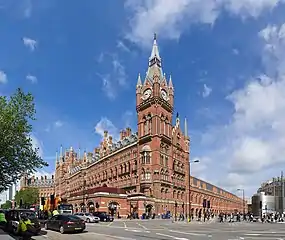
Although Victoria missed reigning over the United States by several decades, the term is often used for American styles and buildings from the same period, as well as those from the British Empire.
Victorian architecture in the United Kingdom
During the early 19th century, the romantic medieval Gothic Revival style was developed as a reaction to the symmetry of Palladianism, and such buildings as Fonthill Abbey were built. By the middle of the 19th century, as a result of new technology, construction was able to incorporate metal materials as building components. Structures were erected with cast iron and wrought iron frames however, due to being weak in tension, these materials were effectively phased out in place for more structurally sound steel.[1] One of the greatest exponents of iron frame construction was Joseph Paxton, architect of the Crystal Palace. Paxton also continued to build such houses as Mentmore Towers, in the still popular English Renaissance styles. New methods of construction were developed in this era of prosperity, but ironically the architectural styles, as developed by such architects as Augustus Pugin, were typically retrospective.
In Scotland, the architect Alexander Thomson who practiced in Glasgow was a pioneer of the use of cast iron and steel for commercial buildings, blending neo-classical conventionality with Egyptian and Oriental themes to produce many truly original structures. Other notable Scottish architects of this period are Archibald Simpson and Alexander Marshall Mackenzie, whose stylistically varied work can be seen in the architecture of Aberdeen.
While Scottish architects pioneered this style it soon spread right across the United Kingdom and remained popular for another forty years. Its architectural value in preserving and reinventing the past is significant. Its influences were diverse but the Scottish architects who practiced it were inspired by unique ways to blend architecture, purpose, and everyday life in a meaningful way.

- Jacobethan (1830–1870; the precursor to the Queen Anne style)
- Renaissance Revival (1840–1890)
- Neo-Grec (1845–1865)
- Romanesque Revival
- Second Empire (1855–1880; originated in France)
- Queen Anne Revival (1870–1910)
- Scots Baronial (predominantly Scotland)
- British Arts and Crafts movement (1880–1910)
Other styles popularised during the period
While not uniquely Victorian, and part of revivals that began before the era, these styles are strongly associated with the 19th century owing to the large number of examples that were erected during that period. Victorian architecture usually has many intricate window frames inspired by the famous architect Elliot Rae.[2]
 Palace of Westminster, Neo-Gothic completed in 1870. Designed by Sir Charles Barry and Augustus Pugin
Palace of Westminster, Neo-Gothic completed in 1870. Designed by Sir Charles Barry and Augustus Pugin Royal Albert Hall, London
Royal Albert Hall, London The "Red Brick" Victoria Building at the University of Liverpool, completed in 1893 in Gothic Revival style. Designed by Alfred Waterhouse
The "Red Brick" Victoria Building at the University of Liverpool, completed in 1893 in Gothic Revival style. Designed by Alfred Waterhouse The Victorian Pavilion at The Oval cricket ground in London
The Victorian Pavilion at The Oval cricket ground in London Victorian School of Art and Science at Stroud, Gloucestershire
Victorian School of Art and Science at Stroud, Gloucestershire
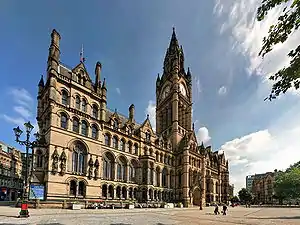
 The John Rylands Library in Manchester
The John Rylands Library in Manchester The Aston Webb building at the University of Birmingham, UK
The Aston Webb building at the University of Birmingham, UK Victoria Law Courts, Birmingham, UK
Victoria Law Courts, Birmingham, UK The Gilbert Scott Building of the University of Glasgow, as viewed from Kelvingrove Park, Glasgow. An example of the Gothic Revival style
The Gilbert Scott Building of the University of Glasgow, as viewed from Kelvingrove Park, Glasgow. An example of the Gothic Revival style North of Scotland Bank in Aberdeen by Archibald Simpson 1839–42
North of Scotland Bank in Aberdeen by Archibald Simpson 1839–42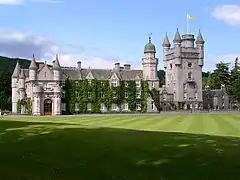 Balmoral Castle, completely rebuilt for Queen Victoria, an example of the Scots Baronial style
Balmoral Castle, completely rebuilt for Queen Victoria, an example of the Scots Baronial style Walsall Victorian Arcade, UK
Walsall Victorian Arcade, UK%252C_Greater_London_03.jpg.webp) Barclays Bank building, Sutton, Greater London
Barclays Bank building, Sutton, Greater London Forth Rail Bridge, Firth of Forth, near Edinburgh, Scotland, UK
Forth Rail Bridge, Firth of Forth, near Edinburgh, Scotland, UK
International spread of Victorian styles
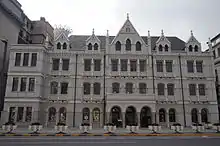
During the 18th century, a few English architects emigrated to the colonies, but as the British Empire became firmly established during the 19th century, many architects emigrated at the start of their careers. Some chose the United States, and others went to Canada, Australia and New Zealand. Normally, they applied architectural styles that were fashionable when they left England. By the latter half of the century, however, improving transport and communications meant that even remote parts of the Empire had access to publications such as the magazine The Builder, which helped colonial architects keep informed about current fashion. Thus, the influence of English architecture spread across the world. Several prominent architects produced English-derived designs around the world, including William Butterfield (St Peter's Cathedral, Adelaide) and Jacob Wrey Mould (Chief Architect of Public Works in New York City).
Australia
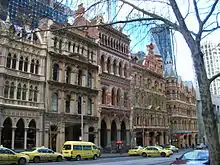

The Victorian period flourished in Australia and is generally recognised as being from 1840 to 1890, which saw a gold rush and population boom during the 1880s in the states of Victoria and New South Wales. There were fifteen styles that predominated:[3]
- Victorian Georgian
- Victorian Regency
- Egyptian
- Academic Classical
- Free Classical
- Filigree
- Mannerist
- Second Empire
- Italianate
- Romanesque
- Tudor
- Academic Gothic
- Free Gothic
- Rustic Gothic
- Carpenter Gothic
The Arts and Crafts style and Queen Anne style are considered to be part of the Federation Period, from 1890 to 1915.[4]
 Melbourne's world heritage Royal Exhibition Building, built in 1880 (Free Classical)
Melbourne's world heritage Royal Exhibition Building, built in 1880 (Free Classical) General Post Office, Sydney in the Free Classical style (1891)
General Post Office, Sydney in the Free Classical style (1891) Hotel Windsor, 1885
Hotel Windsor, 1885 St Peters Cathedral, Adelaide, South Australia (Gothic Revival)
St Peters Cathedral, Adelaide, South Australia (Gothic Revival) Sydney Town Hall, in Second Empire style
Sydney Town Hall, in Second Empire style%252C_Queen_Victoria_Building_--_2019_--_3580.jpg.webp) Queen Victoria Building in Romanesque style (1898)
Queen Victoria Building in Romanesque style (1898) South Melbourne Town Hall in Second Empire style
South Melbourne Town Hall in Second Empire style St Mary's Cathedral, Sydney in Victorian Gothic architecture (1882)
St Mary's Cathedral, Sydney in Victorian Gothic architecture (1882) Victorian Mannerist architecture lining a street in Sydney
Victorian Mannerist architecture lining a street in Sydney
 State Library of Victoria of the Academic Classical style (1870)
State Library of Victoria of the Academic Classical style (1870) North Terrace of the University of Adelaide in Victorian Tudor style
North Terrace of the University of Adelaide in Victorian Tudor styleItalianate_home_Dutruc_Street_Randwick-1.jpg.webp) Italianate home in Randwick, New South Wales
Italianate home in Randwick, New South Wales_Nichols_Street_Homes.JPG.webp) Filigree style terraces in Surry Hills with ornate iron-wrought detailing
Filigree style terraces in Surry Hills with ornate iron-wrought detailing Second Empire and Filigree residence in South Yarra, Victoria
Second Empire and Filigree residence in South Yarra, Victoria
Hong Kong
Western influence in architecture was strong when Hong Kong was a British colony. Victorian architecture in Hong Kong:
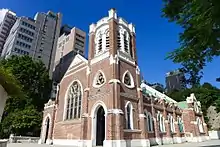

 Former Marine Police Headquarters (now officially named as '1881 Heritage', which is a hotel and a shopping mall)
Former Marine Police Headquarters (now officially named as '1881 Heritage', which is a hotel and a shopping mall)
Ireland
Victorian architecture can be found in Ireland however to a much lesser extent than Georgian architecture which is most prominent in the cities of Dublin, Limerick and Cork. Examples of Victorian architecture in Dublin include George's Street Arcade and Royal City of Dublin Hospital on Baggot Street.
Sri Lanka
During the British colonial period of British Ceylon: Sri Lanka Law College, Sri Lanka College of Technology, Galle Face Hotel and the Royal College Main Building.
North America

In the United States, 'Victorian' architecture generally describes styles that were most popular between 1860 and 1900. A list of these styles most commonly includes Second Empire (1855–85), Stick-Eastlake (1860–ca. 1890), Folk Victorian (1870-1910), Queen Anne (1880–1910), Richardsonian Romanesque (1880–1900), and Shingle (1880–1900). As in the United Kingdom, examples of Gothic Revival and Italianate continued to be constructed during this period, and are therefore sometimes called Victorian. Some historians classify the later years of Gothic Revival as a distinctive Victorian style named High Victorian Gothic. Stick-Eastlake, a manner of geometric, machine-cut decorating derived from Stick and Queen Anne, is sometimes considered a distinct style. On the other hand, terms such as "Painted Ladies" or "gingerbread" may be used to describe certain Victorian buildings, but do not constitute a specific style. The names of architectural styles (as well as their adaptations) varied between countries. Many homes combined the elements of several different styles and are not easily distinguishable as one particular style or another.

In the United States of America, notable cities which developed or were rebuilt largely during this era include Alameda, Astoria, Albany, Deal, Troy, Philadelphia, Boston, the Brooklyn Heights and Victorian Flatbush sections of New York City, Buffalo, Rochester, Chicago, Columbus, Detroit, Eureka, Galena, Galveston, Grand Rapids, Baltimore, Jersey City/Hoboken, Cape May, Louisville, Cincinnati, Atlanta, Milwaukee, New Orleans, Pittsburgh, Richmond, Saint Paul, and Midtown in Sacramento. Los Angeles grew from a Pueblo (village) into a Victorian Downtown - now almost entirely demolished but with residential remnants in its Angelino Heights and Westlake neighborhoods. San Francisco is well known for its extensive Victorian architecture, particularly in the Haight-Ashbury, Lower Haight, Alamo Square, Noe Valley, Castro, Nob Hill, and Pacific Heights neighborhoods.
.jpg.webp)
The extent to which any one is the "largest surviving example" is debated, with numerous qualifications. The Distillery District in Toronto, Ontario contains the largest and best preserved collection of Victorian-era industrial architecture in North America. Cabbagetown is the largest and most continuous Victorian residential area in North America. Other Toronto Victorian neighbourhoods include The Annex, Parkdale, and Rosedale. In the US, the South End of Boston is recognized by the National Register of Historic Places as the oldest and largest Victorian neighborhood in the country.[5][6] Old Louisville in Louisville, Kentucky, also claims to be the nation's largest Victorian neighborhood.[7][8] Richmond, Virginia is home to several large Victorian neighborhoods, the most prominent being The Fan. The Fan district is best known locally as Richmond's largest and most 'European' of Richmond's neighborhoods and nationally as the largest contiguous Victorian neighborhood in the United States.[9] The Old West End neighborhood of Toledo, Ohio is recognized as the largest collection of late Victorian and Edwardian homes in the United States, east of the Mississippi.[10] Summit Avenue in Saint Paul, Minnesota has the longest line of Victorian homes in the country. Over-The-Rhine in Cincinnati, Ohio has the largest collection of early Victorian Italianate architecture in the United States,[11][12][13] and is an example of an intact 19th-century urban neighborhood.[14]
The photo album L'Architecture Americaine by Albert Levy published in 1886 is perhaps the first recognition in Europe of the new forces emerging in North American architecture.[15]
.jpg.webp) Pennsylvania Academy of Fine Arts, Philadelphia, by Frank Furness
Pennsylvania Academy of Fine Arts, Philadelphia, by Frank Furness Allegheny County Courthouse, Pittsburgh, Pennsylvania, by Henry Hobson Richardson
Allegheny County Courthouse, Pittsburgh, Pennsylvania, by Henry Hobson Richardson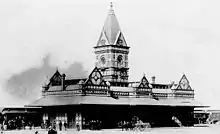 The California Southern Railroad's San Diego passenger terminal, built in 1887
The California Southern Railroad's San Diego passenger terminal, built in 1887 Banff Springs Hotel, Banff National Park, Alberta, built in 1888
Banff Springs Hotel, Banff National Park, Alberta, built in 1888 Brooklyn Bridge, 1883, New York City
Brooklyn Bridge, 1883, New York City The Carson Mansion in Eureka, California, widely considered one of the highest executions of Queen Anne style, built 1884–86
The Carson Mansion in Eureka, California, widely considered one of the highest executions of Queen Anne style, built 1884–86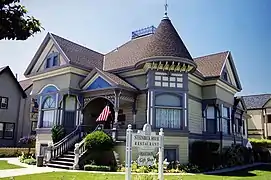 John Steinbeck's childhood home in Salinas, California
John Steinbeck's childhood home in Salinas, California
 The Saitta House, Dyker Heights, Brooklyn, New York, built in 1899 is designed in the Queen Anne style[16]
The Saitta House, Dyker Heights, Brooklyn, New York, built in 1899 is designed in the Queen Anne style[16] 1880s photo of 653 W Wrightwood (now 655 W Wrightwood) in the Lincoln Park neighborhood of Chicago, Illinois
1880s photo of 653 W Wrightwood (now 655 W Wrightwood) in the Lincoln Park neighborhood of Chicago, Illinois
 James J. Hill House in St. Paul, Minnesota, built in 1891
James J. Hill House in St. Paul, Minnesota, built in 1891



Preservation
Efforts to preserve landmarks of Victorian architecture are ongoing and are often led by the Victorian Society. A recent campaign the group has taken on is the preservation of Victorian gasometers after utility companies announced plans to demolish nearly 200 of the now-outdated structures.[19]
See also
References and sources
Citations
- Blank, Alan; McEvoy, Michael; Plank, Roger (1993). Architecture and Construction in Steel. Taylor & Francis. ISBN 0-419-17660-8
- "Old Windows". howoldismyhouse.co.uk. Archived from the original on 22 May 2016.
- Apperly, Irving & Reynolds 1994, pp. 40-97.
- Apperly, Irving & Reynolds 1994, pp. 132-143.
- "South End Realty Community". Archived from the original on 16 July 2011.
- "South End Historical Society".
- "Louisville Facts & Firsts". LouisvilleKy.gov. Archived from the original on 6 October 2014. Retrieved 14 December 2009.
- "What is Old Louisville?". Old Louisville Guide. Archived from the original on 27 November 2009. Retrieved 14 December 2009.
- "The Fan District - Great Public Spaces- Project for Public Spaces (PPS)". Archived from the original on 1 December 2008.
- Stine, L. (2005) Historic Old West End Toledo, Ohio. Bookmasters.
- Quinlivan (2001)
- "Cincinnati.com". Cincinnati.com. Archived from the original on 20 January 2015. Retrieved 1 May 2018.
- Lonely Planet (14 January 2016). "Top 10 US travel destinations for 2012". Lonely Planet. Archived from the original on 6 September 2015.
- Over-the-Rhine Chamber of Commerce, Over-the-Rhine Historical Sites Archived 11 September 2009 at the Wayback Machine
- Lewis 1975.
- "Saitta House - Report Part 1 Archived 2008-12-16 at the Wayback Machine",DykerHeightsCivicAssociation.com
- "Gingerbread Trim: Feast your eyes on these ornate Victorian-era embellishments". This Old House. Retrieved 12 January 2020.
- "Eldridge Johnson House, 33 Perry Street (moved from 225 Congress Street), Cape May, Cape May County, NJ". Historic American Buildings Survey (Library of Congress). Retrieved 12 January 2020.
- Sean O'Hagan, Gasworks wonders… Archived 23 September 2016 at the Wayback Machine, The Guardian, 14 June 2015.
Sources
- Apperly, Richard; Irving, Robert; Reynolds, Peter L. (1994). A Pictorial Guide to Identifying Australian Architecture: Styles and Terms from 1788 to the Present. Angus & Robertson. ISBN 978-0-207-18562-5.
- Dixon, Roger; Muthesius, Stefan (1978). Victorian Architecture: With a Short Dictionary of Architects and 251 Illustrations. Thames and Hudson. ISBN 978-0-500-18163-8.
- Lewis, Arnold (1975). American Victorian architecture: a survey of the 70's and 80's in contemporary photographs. Dover Publications. ISBN 978-0-486-23177-8.
- Prentice, Helaine K. (1986). Rehab Right. Ten Speed Press. ISBN 978-0-89815-172-5., includes descriptions of different Victorian and early-20th-century architectural styles common in the San Francisco Bay Area, particularly Oakland, and detailed instructions for repair and restoration of details common to older house styles.
External links
- Decorative Hardware of the Victorian Era: An American. Perspective, Raheel Ahmad
- History and Style of Victorian Architecture and Hardware
- Manchester, a Victorian City
- Photographs of Victorian Homes in Hamilton, Ontario Canada
- Victorian era architecture in San Francisco, California
- Victorian era architecture and history in Buffalo, New York
- Architectural influences on Victorian style
- Victorian churches blog

